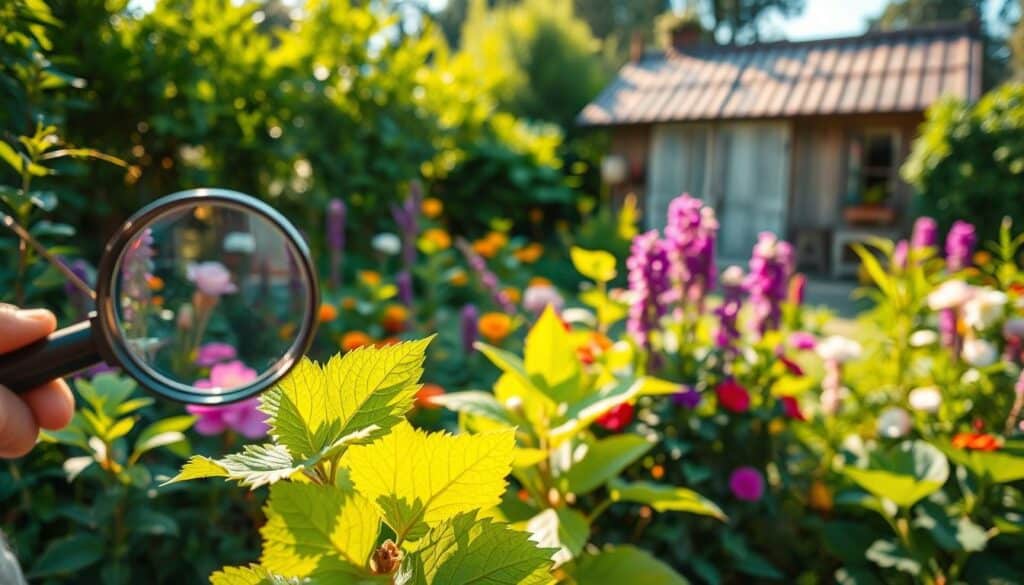Anúncios
Reaching success in plant growth involves choosing the right grow mediums and methods. This article explores different grow mediums such as soil, soilless mixes, and hydroponics. We’ll look at how each affects plant health, yield, and overall gardening success. By knowing the unique traits of these mediums, both new and skilled gardeners can improve how they grow plants. We’ll also share important gardening tips. These tips will help improve your growing techniques, making sure your plants are as healthy and productive as possible.
Understanding Grow Mediums
Grow mediums are key to raising healthy plants. They offer support, nutrients, and good air flow for roots. Knowing the different types helps gardeners choose the best one for their needs.
Anúncios
Types of Grow Mediums
The main types of grow mediums include:
- Traditional soil, which supplies natural nutrients and a habitat for beneficial microorganisms
- Soilless mixes, often formulated with peat moss, perlite, and vermiculite, designed to optimize drainage and aeration
- Hydroponic solutions that rely solely on nutrient-rich water to support plant growth
Importance of Soil Quality
Soil quality massively impacts how well plants do. Things like pH levels, nutrients, and how well soil drains play a big role. Managing soil quality well means plants grow better, making it very important for gardeners.
Soil: The Traditional Grow Medium
Soil is the most common way to grow plants because it’s full of nutrients. It’s vital to have good drainage and airflow in the soil for roots to do well. Loamy soil, which is a mix of sand, silt, and clay, is best for plant growth.
Key Considerations for Soil
Choosing the right soil means thinking about a few important things:
- Drainage capabilities to prevent waterlogged roots
- Aeration that promotes healthy root growth
- pH levels to ensure nutrient availability
- Organic matter content for balanced nutrient supply
Enhancing Nutrient Content
Boosting the nutrients in soil can really help plants grow better. Adding compost or aged manure can enrich the soil. This doesn’t just add nutrients, it also encourages helpful microbes in the soil. Using organic materials like these keeps the soil fertile and great for plants.
Soilless Mixes and Their Advantages
Soilless mixes are becoming a top choice for gardeners and growers. They’re made of coco coir, peat moss, perlite, and vermiculite. These ingredients create a perfect place for plants to grow by improving drainage and airflow. Let’s explore what’s in these mixes and why they’re great for plants.
Components of Soilless Mixes
The main parts of soilless mixes are:
- Coco coir: Comes from coconut husks, retains moisture well, and enhances air flow.
- Peat moss: Holds water and nutrients, adding vital organic matter to the mix.
- Perlite: A type of volcanic glass that keeps the mix light and improves drainage.
- Vermiculite: Helps hold moisture and makes nutrients more available to plants.
Benefits of Using Soilless Mixes
There are several pluses to using soilless mixes for growing plants:
- Better drainage helps prevent root rot, leading to healthier roots.
- They reduce the chance of soil-borne diseases.
- Allows more precise nutrient management, which helps plants grow better.
- Keeps plants hydrated evenly, which is key for proper growth.
Hydroponics: A Modern Approach to Plant Growth
Hydroponics is changing the way we grow plants, with a water solution full of nutrients instead of soil. This method has created various hydroponic systems designed for different growing needs and choices.
Types of Hydroponic Systems
There are many hydroponic systems out there, each with its own perks:
- Deep Water Culture (DWC): Plants hang in nutrient-rich water, their roots deep in the solution for lots of oxygen.
- Nutrient Film Technique (NFT): A constant stream of nutrient solution covers the plant roots, giving them all the nutrients they need.
- Ebb and Flow systems: These flood the plants with nutrient solutions then drain back, making sure plants get the moisture and nutrients they need.
Advantages of Hydroponic Growing
Hydroponics offers many benefits:
- It allows precise control over the nutrient mix, so plants get exactly what they need for healthy growth.
- There’s better pH management, which helps plants absorb nutrients more efficiently.
- The growth rate of plants is faster, which means more yield in less time.
- It’s also space-saving, perfect for cities where traditional gardening might not work.
Maximizing Growth Through Proper Nutrition
To get plants really healthy, you need to know a lot about nutrition. It’s important for their growth and strength. It’s all about the right mix of the big and small nutrients, making sure plants get what they need when they need it.
Nutrients Essential for Plant Health
The big nutrients—nitrogen, phosphorus, and potassium—are super important for plants. Nitrogen makes the leaves grow, phosphorus is for roots and flowers, and potassium keeps the plant tough. Plants also need tiny but key nutrients like iron, magnesium, and calcium for making food and green stuff. A good feeding plan covers all these nutrients all through the plant’s life.
Regular Nutrient Testing
Checking nutrients regularly is a must. Testing the soil or nutrient mixes helps find what’s missing or too much. This info helps adjust feeding plans to keep plants growing well. Using slow-release feeds or mixes, especially in water gardens, ensures plants always have the nutrients they need for strong growth at all stages.
Optimizing Lighting Conditions
Effective lighting helps plants grow, impacting their development stages. Understanding grow lights and their schedules is key for plant health and yield. Growers can pick from various lighting types to suit their plants’ needs. This ensures plants get the right light spectrum at the perfect time.
Types of Grow Lights
Choosing the right grow lights is essential for plant growth. Some top lighting options include:
- LED Grow Lights: These allow growers to use specific light wavelengths for different growth stages. Blue light supports strong vegetative growth while red light aids in flowering. This targeted approach improves plant health and can lead to higher yields.
- Fluorescent Grow Lights: Offering a wider spectrum, fluorescent lights are less efficient than LEDs for plants with high light needs. However, they are suitable for seedlings and young plants. They don’t offer the precision that LEDs do.
Understanding Light Schedules
Light schedules guide plants through growth phases. For instance, cannabis plants need certain light schedules as they are photoperiod plants. During the vegetative state, providing 18-24 hours of light each day promotes growth. To start flowering, a cycle of 12 hours of light and 12 hours of darkness is needed. This uninterrupted darkness is crucial to avoid early flowering.
Different plants need various light amounts during their growth. Here are some tips:
- Seedling Stage: 16-18 hours of light daily with strong light intensity to prevent legginess.
- Vegetative Stage: 18-24 hours of light to encourage fast growth.
- Flowering Stage: Short-day plants require 12 hours of light and darkness. Long-day plants need 14-16 hours of light. Day-neutral plants do well with 12-16 hours of light.
Knowing and using the right light cycles is crucial for healthy plant development and maximizing growth.
Water Management Techniques
Proper water management is key to keeping plants healthy. Too much or too little water causes problems for growers. Using the right watering techniques means plants get the moisture they need. This also helps keep the roots healthy by ensuring good drainage.
Best Practices for Watering
Drip irrigation is a smart watering method. It sends water straight to the roots. This saves water and stops diseases by keeping leaves dry. Checking the soil’s moisture with tools like a moisture meter or your finger tells you when to water. This avoids both over and under-watering.
- Utilize drip irrigation to save time and provide consistent moisture.
- Monitor moisture levels to avoid over and underwatering.
- Encourage deep watering to promote deeper root growth.
Importance of Drainage
Good drainage is crucial to avoid soggy soils that cause root rot and slow root growth. Soil that drains well has space for both water and air, which plants need to be healthy. To get better drainage, add things like compost or shredded leaves to your soil. Proper drainage protects your plants and helps them grow better.
- Integrate organic matter to enhance soil drainage.
- Regularly assess soil for drainage capabilities.
- Prioritize preventing root rot through effective drainage solutions.
Understanding Climate Control
Getting the climate right for plants is key to their health and how much they produce. Managing the right temperature and humidity is essential for plants to grow well. Keeping these elements at the best levels boosts the chances for plants to develop successfully.
Temperature and Humidity Roles
Temperature control influences how fast plants grow and when they bloom. On the other hand, managing humidity is important for water movement and food absorption in plants. They do well when the warmth and moisture suit their needs, avoiding stress and encouraging strong growth.
Strategies for Ventilation
Ventilation is crucial for a perfect growing space. Here are some tips:
- Use exhaust fans to get rid of too much heat.
- Bring in fresh air with intake fans.
- Install fans to move air around, which lowers moisture.
- Keep an eye on CO2 for the best plant growth.
These tips help balance temperature and moisture, making a great environment for plants to grow.
Pest and Disease Management Strategies
Keeping plants healthy involves managing pests and diseases well. Using different preventive methods can greatly lower the chances of problems in your garden. With Integrated Pest Management (IPM), we mix biological, cultural, physical, and chemical ways. This helps keep pests away and protects the environment.
Preventive Measures for Pest Control
Being proactive helps fight off pests and diseases before they start. Here are some smart ways to do this:
- Regularly inspect plants for early signs of pests and diseases.
- Maintain proper spacing between plants to enhance airflow.
- Utilize companion planting to deter pests naturally.
- Implement crop rotation to disrupt pest life cycles.
The Importance of Tool Sterilization
Keeping your tools clean is key to stopping diseases in the garden. Clean tools won’t spread germs from one plant to another. Make sure to disinfect your gardening tools regularly. You can do this by:
- Soaking tools in a bleach solution before use.
- Wiping tools with alcohol wipes after each use.
- Sharpening and cleaning blades to remove residues.
By doing these things, gardeners can fight pests and diseases. This leads to a thriving garden.

Conclusion
Improving plant growth combines knowledge of various growing mediums with good growth strategies. Sustainable gardening focuses on essential things. Like the environment, nutrients, water, and keeping pests away. All these factors work together to make plants healthy and produce a lot.
Growing in soil, using soilless mixes, or hydroponics each have their own benefits. They can boost your garden’s productivity. By using the methods mentioned in this article, you can make the most of your plants. This will lead to a successful garden or farm.
At its heart, successful gardening means taking great care of your plants. Understanding and improving how plants grow is key. This approach will make your garden flourish and give you lots of produce.



